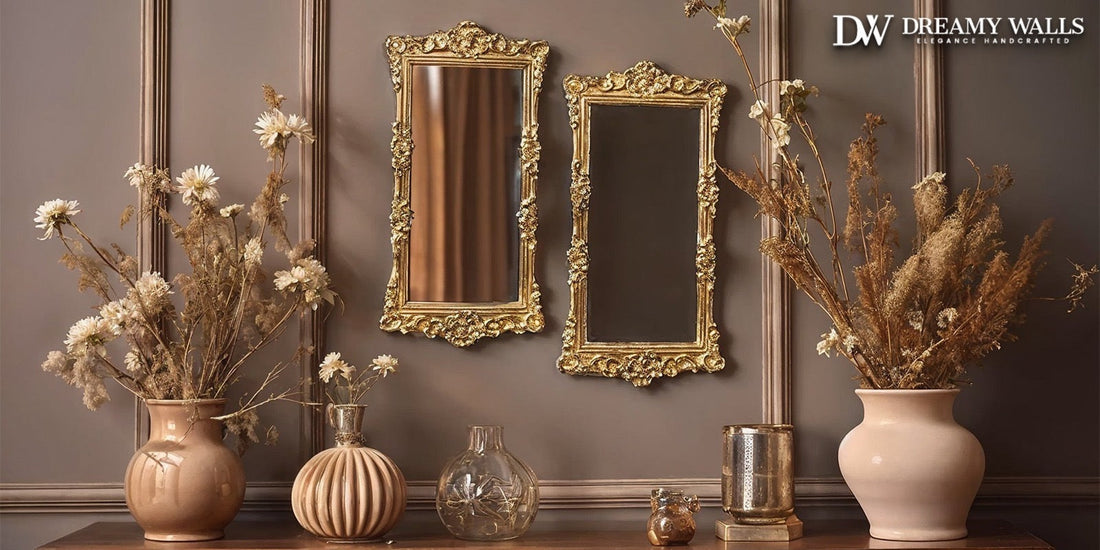
Mirror Decor Ideas to Elevate Your Home Aesthetics
What is a Mirror? Exploring Its Definition
A mirror is a reflective surface, usually made of glass with a metal-coated backing, designed to reflect light and create a clear image of objects in front of it. Mirrors serve both functional and aesthetic purposes, commonly used in homes, offices, vehicles, and optical devices. The science of reflection allows mirrors to provide depth, enhance lighting, and contribute to interior design. With various types like plane, concave, and convex mirrors, they cater to different needs, from personal grooming to architectural and decorative enhancements.

How Mirrors Are Made: The Science Behind Reflection
The process of making mirrors involves several intricate steps. Initially, a sheet of high-quality glass is selected, as it provides the best clarity and smoothness. The glass is then coated with a reflective metal, usually silver, aluminum, or a combination of chemical compounds, ensuring an even and durable finish. A protective layer is applied to prevent oxidation and damage. The reflective quality of a mirror is achieved through this metal coating, which allows light to bounce back, creating a sharp and accurate reflection. Understanding how mirrors are made helps in appreciating their quality, durability, and different applications in home decor and practical usage.
Understanding the Different Types of Mirrors and Their Applications
Mirrors come in various types, each serving a specific function:
1.Decorative Mirrors
Decorative mirrors elevate home interiors with their stylish designs and versatility. Whether round, square, or asymmetrical, these mirrors serve as statement pieces. From vintage wood frame mirrors to sleek and modern metal designs, decorative wall mirrors can be strategically placed to enhance the ambiance of a living space. Mirrors with intricate frames, gold or silver finishes, and even custom carvings offer a personal touch to any home decor style.
2.Round, Square, and Asymmetrical Mirrors
The shape of a mirror plays a crucial role in defining its impact:
1.Round Mirrors: Soft and elegant, ideal for living rooms, bedrooms, and bathrooms, offering a balanced aesthetic.
2.Square Mirrors: Provide a structured look, commonly used in modern and minimalist interior designs.
3.Asymmetrical Mirrors: Artistic and contemporary, these add character to a space, making them perfect for accent walls and unique decor arrangements.
3.Vintage and Antique Mirrors
Vintage and antique mirrors add a sense of nostalgia and elegance to home interiors. Crafted with ornate wooden or metal frames, they are often distressed to retain their old-world charm. These mirrors are ideal for traditional, rustic, or eclectic decor styles, adding depth and personality to a space. Whether placed above a fireplace, in a foyer, or as a bedroom wall mirror, antique mirrors exude timeless beauty.
4.Mirrors with Lights
Mirrors with integrated lighting are gaining popularity due to their functionality and modern appeal. Bathroom mirrors with storage and LED lights provide both utility and sophistication. These mirrors are commonly used in dressing areas, providing optimal lighting for makeup application and grooming. Round mirrors with light also add a sleek, futuristic look to contemporary interiors.
What Are the Practical Uses of Mirrors in Everyday Life?
Mirrors play an essential role in daily life beyond aesthetics:
1.Personal Grooming: Dressing table mirrors, wall-mounted bathroom mirrors, and compact mirrors help with daily routines.
2.Security and Safety: Convex mirrors in parking areas and rear-view mirrors in vehicles enhance visibility.
3.Interior Design: Used in mirror wall design ideas to create an illusion of space and brightness.
Scientific and Medical Applications: Used in optical instruments, medical imaging, and telescopes.
The Role of Mirrors in Interior Design: Enhancing Space and Light
Mirrors are a designer’s best friend, as they enhance space perception and light reflection. A well-placed long wall mirror can make a narrow hallway appear more spacious. Living room mirrors placed opposite windows amplify natural light, brightening the space. Dining wall mirrors add elegance, while bedroom standing mirrors offer practicality and style.
How Mirrors Can Transform Small Spaces Into Bright, Open Rooms
For small spaces, mirrors serve as an effective decor tool:
1.Creating Depth: A wall of mirrors can make a room feel double its size.
2.Reflecting Light: Placing a mirror opposite a light source maximizes brightness.
3.Strategic Placement: Dining room wall mirrors enhance elegance, while door mirrors serve a dual purpose in compact areas.
4.Mirror Panels: Living room mirror wall panels create a sophisticated and modern look.
Styling Mirrors in Different Rooms
Living Room and Dining Room
How to Style Living Room Mirrors for a Spacious Look
Living room mirrors can be strategically placed to create an illusion of space and enhance natural light. A large mirror positioned opposite a window will reflect sunlight, making the room feel brighter and more expansive. Using a statement piece, such as a round mirror or an asymmetrical design, adds character while maintaining functionality.
Dining Room Mirror Wall Ideas: Adding Depth and Sophistication
Dining room mirrors bring a sense of sophistication and openness. A full-length dining wall mirror or a mirrored panel wall adds an element of grandeur, making the space feel larger. Placing mirrors with elegant frames enhances the overall dining experience, creating a luxurious ambiance.
Creating a Focal Point with Living Room Mirror Wall Panels
Mirror wall panels in the living room create a dramatic effect. Whether arranged in a geometric pattern or used as a floor-to-ceiling feature, they add depth and style. Combining mirrors with decorative elements such as sconces or artwork can create a balanced and visually appealing interior.
Bedroom
Stylish Bedroom Wall Mirror Ideas for a Cozy Retreat
Bedroom wall mirrors are both functional and decorative. Placing a large mirror above the bed or on a wardrobe door enhances the aesthetic appeal while creating the illusion of extra space. A wooden frame mirror adds warmth, while a sleek, modern design complements contemporary interiors.
How to Incorporate Standing Mirrors in Bedroom Design
A bedroom standing mirror offers versatilithttps://www.dreamywalls.com/blogs/articles/home-decor-on-a-budgety and elegance. It can be placed in a corner for a dressing area effect or leaned against the wall for a relaxed, modern look. Opting for an ornate vintage mirror adds a touch of classic sophistication.
Long Mirrors for Bedrooms: Function Meets Aesthetic
Long mirrors serve a dual purpose in the bedroom by providing a full-length reflection while acting as a stylish decor piece. They can be integrated into wardrobe doors, mounted on walls, or used as freestanding mirrors to make the space feel taller and more elegant.
Bathroom
Bathroom Mirror Ideas: From Storage Solutions to Decorative Designs
Bathrooms benefit greatly from functional and decorative mirrors. A bathroom mirror with storage provides practical solutions for small spaces, keeping essentials within reach. Decorative wall mirrors with stylish frames add a luxurious feel to the bathroom decor.
How to Choose the Perfect Bathroom Wall Mirror for Your Style
Selecting the right bathroom mirror depends on the overall design theme. A minimalist frameless mirror works well in modern bathrooms, while vintage wood frame mirrors suit rustic or classic interiors. Consider a mirror with built-in storage for added functionality.
Enhancing Functionality with Bathroom Mirrors with Lights
Mirrors with lights enhance bathroom functionality by providing optimal illumination for grooming tasks. LED-lit mirrors offer a sleek, contemporary look and energy-efficient lighting. Backlit mirrors create a soft glow, adding a spa-like ambiance to the space.
Kids' and Study Rooms
Kid-Friendly Mirror Designs for Playful and Safe Decor
Mirrors in children's rooms should be both decorative and safe. Using shatterproof materials and rounded edges minimizes risks. Fun shapes such as hexagon mirrors or themed designs add a playful element to the decor while fostering creativity and self-expression.
Adding Mirrors to Study Rooms for Bright and Functional Spaces
Study rooms benefit from mirrors that reflect natural light, reducing the need for artificial lighting. Placing a mirror near a window enhances brightness and creates a productive atmosphere. A small table mirror or a simple wall mirror can add a touch of sophistication without overwhelming the space.
Wood Frame Mirrors: Rustic Charm Meets Contemporary Style
Wood frame mirrors bring a touch of warmth and elegance to any space. Their versatility allows them to fit seamlessly into both rustic and contemporary interiors. Whether it's a vintage wood frame mirror with intricate carvings or a sleek modern wooden border, these mirrors offer timeless appeal. A wood frame wall mirror can act as a focal point in a living room, bedroom, or entryway. Additionally, a wood wall mirror blends naturally with earthy decor, enhancing the overall ambiance. For those looking to add a rustic feel to their interiors, distressed or reclaimed wood frame mirrors provide a charming and eco-friendly choice.
Mirrors as Timeless Design Elements: Style, Functionality, and Versatility
Mirrors have long been a staple in interior design due to their ability to merge style with function. Their reflective quality not only enhances the aesthetics of a space but also serves practical purposes such as increasing light, creating an illusion of depth, and elevating decor themes. Whether used as statement pieces in a grand entryway or incorporated subtly into a minimalist design, mirrors adapt to any style. From contemporary frameless designs to intricate antique frames, mirrors add character, openness, and sophistication to a home. Their versatility ensures they remain a fundamental element of interior decor for years to come.
Conclusion
Mirrors are more than just reflective surfaces; they are essential elements in home decor, offering style, functionality, and versatility. Whether enhancing natural light, creating the illusion of space, or adding an elegant touch to interiors, mirrors remain timeless design features.
Shop Now at Dreamywalls and Find the Perfect Mirror to Elevate Your Space!
Frequently Asked Questions
1.What are the best ways to clean a mirror without streaks?
Use a microfiber cloth with a vinegar-water solution. Wipe in a circular motion, then finish with vertical strokes for a streak-free shine.
2.How can I decorate a mirror wall for maximum impact?
Use varying sizes, stylish frames, or backlighting. Arrange symmetrically for elegance or asymmetrically for modern appeal.
3.What is the most suitable mirror type for small spaces?
Wall-mounted, frameless, or floor-to-ceiling mirrors create an illusion of depth without occupying extra space.
4.Can mirrors be used to make a room look larger?
Yes! Placing large mirrors opposite windows reflects light, making rooms appear more spacious and bright.
5.What are some safety tips for using mirrors in homes with children?
Secure mirrors firmly, use shatterproof glass, avoid placing them at low heights, and choose rounded edges to prevent injuries.
"DreamyWalls stands by the W-A-L-L-S principles. Every product we create and every idea we share is built on Well-crafted Artistry and Lifelong Learning. We are committed to Authenticity, Loyalty to Quality, and Superior Standards, ensuring that your spaces reflect beauty and personality."
"W-A-L-L-S"(Well-crafted Artistry,Authenticity,Lifelong Learning,Loyalty to Quality,Superior Standards)
